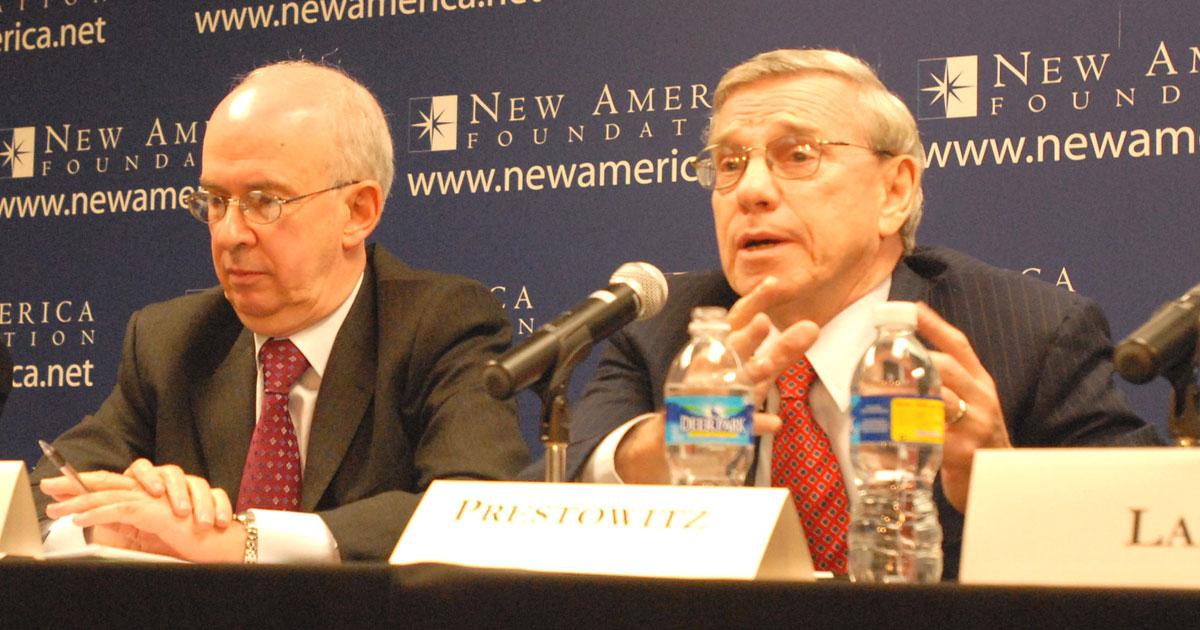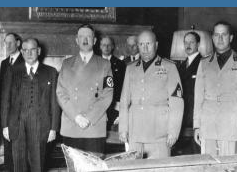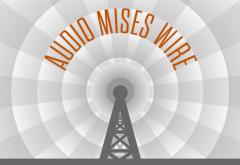When Ronald Reagan officially announced his candidacy for president of the United States in November 1979, he called for the establishment of a large free trade zone encompassing the USA, Canada, and Mexico. Not surprisingly, the so-called free trade agreement better known as the North American Free Trade Agreement (NAFTA) resembled the usual “managed trade” that falls much more into the category of what Randall Holcombe calls “political capitalism.” Politics has a way of doing that. For all of the logic of theories of free trade and for all of the prosperity that has come about as international trade has expanded in the past few decades, freedom of exchange over international borders will always have its enemies. On the progressive Left, we have seen the
Topics:
William L. Anderson considers the following as important: 6b) Mises.org, Featured, newsletter
This could be interesting, too:
Nachrichten Ticker - www.finanzen.ch writes Die Performance der Kryptowährungen in KW 9: Das hat sich bei Bitcoin, Ether & Co. getan
Nachrichten Ticker - www.finanzen.ch writes Wer verbirgt sich hinter der Ethereum-Technologie?
Martin Hartmann writes Eine Analyse nach den Lehren von Milton Friedman
Marc Chandler writes March 2025 Monthly
 When Ronald Reagan officially announced his candidacy for president of the United States in November 1979, he called for the establishment of a large free trade zone encompassing the USA, Canada, and Mexico. Not surprisingly, the so-called free trade agreement better known as the North American Free Trade Agreement (NAFTA) resembled the usual “managed trade” that falls much more into the category of what Randall Holcombe calls “political capitalism.” Politics has a way of doing that.
When Ronald Reagan officially announced his candidacy for president of the United States in November 1979, he called for the establishment of a large free trade zone encompassing the USA, Canada, and Mexico. Not surprisingly, the so-called free trade agreement better known as the North American Free Trade Agreement (NAFTA) resembled the usual “managed trade” that falls much more into the category of what Randall Holcombe calls “political capitalism.” Politics has a way of doing that.
For all of the logic of theories of free trade and for all of the prosperity that has come about as international trade has expanded in the past few decades, freedom of exchange over international borders will always have its enemies. On the progressive Left, we have seen the political candidacies of Bernie Sanders and Elizabeth Warren, both of whom are hardcore protectionists.
Conservatives, however, have opposed free trade for decades and seem to be impervious to any arguments to the contrary, no matter how logical free trade policies might be. In a recent edition of the American Conservative, Clyde Prestowitz praises President Joe Biden’s proposal to heavily subsidize the US semiconductor industry. He writes:
President Biden has proposed that the U.S. government invest billions of dollars in the pivotal U.S. semiconductor industry as part of an effort to assure continued global leadership. It is a break with 70 years of U.S. free-trade doctrine, as well as a huge step back to America’s future.
While one can write volumes on the meaning of “invest” in that statement, nonetheless there is much more to understanding just how fallacious this latest conservative argument for “managed trade” really is. President Bill Clinton used that term regularly as a euphemism for more spending, and politicians recklessly have used the terminology ever since.
However, what exactly would be Biden’s “investments”? Will the federal government be financing new capital expenditures for US companies and, if so, what are the terms of financing and how will the capital be directed? Government “investments” by definition are political expenditures and require political outcomes, none of which will meet actual needs in the US economy.
Like so many conservatives that call for some forms of autarky, Prestowitz conjures up an American past that in his thinking was made possible only by protective tariffs. He writes:
This is a return to the trail first blazed by Alexander Hamilton in 1791. Hamilton proposed mimicking Britain’s budding industrial revolution by copying its technology, imposing tariffs on imports of manufactures and providing financial incentives for the development of domestic manufacturing.
Hamilton was initially opposed by Thomas Jefferson, who dreamed of an America of yeoman farmers trading produce and raw materials like timber for imported manufactures. The outcome of the debate was determined by the War of 1812, which the U.S. nearly lost for want of manufacturing capability. In its wake, Jefferson yielded to Hamilton, noting that manufactures were “as necessary to our independence as to our comfort.”
The ensuing Tariff Act of 1816 launched a 132-year U.S. policy of imposing high duties on manufactured imports while subsidizing domestic industrial and technological development. Known as the “American System,” it led to the establishment of the Erie Canal, the telegraph, the transcontinental railway, and the world’s leading industries in steel, farm equipment, chemicals, autos, aviation, and engineering—along with the creation of the world’s largest economy by 1890 and the greatest economic mobilization ever seen in America’s World War II victory.
Prestowitz then goes on to construct a history that never was:
After the war, America ironically abandoned the American System and turned toward the Jeffersonian. There were two reasons. First, by dint of the American System and the nation’s victory in WWII, the United States had become the world leader in virtually every industry and no longer needed protectionist policies.
Second, many economists believed that U.S. tariff increases in the 1930s had both exacerbated the Great Depression and contributed to the outbreak of WWII. Led by the great John Maynard Keynes, they preached free trade as the road to both economic growth and peace. Thus was the postwar trading system founded in 1948 on free-trade principles.
Those associated with the Austrian school of economics know that we can call Keynes many things but “great” is not among them. While there is much to digest in the preceding paragraphs, one can be sure that American prosperity and the rise of large-scale manufacturing did not come about because the governments at all levels restricted trade. For that matter, as economic historians like Robert Higgs and Tom DiLorenzo have noted, many of the so-called American System projects, especially those involved with transportation via canals and railroads, were neither models of economy nor free of massive corruption.
(Because of limitations of space, I defer to excellent works on US economic history by Higgs, DiLorenzo, and Burton Folsom, who have looked at the so-called American System in detail and find a gap between the myths and the facts.)
The growth of industries such as steel and the development of the automobile did not come about because the USA had high protective tariffs but rather because entrepreneurs had the freedom to pursue profitable ideas. Yes, a system of high protective tariffs did exist at that time, but to say that tariffs and other government-sponsored projects such as canals or railroad subsidies created prosperity is to engage in the post hoc ergo propter hoc fallacy. Furthermore, if protectionism creates prosperity, as the author claims, then how can one reconcile the fruits of protectionism with the fact that the USA itself is a very large free trade zone in which people within states and localities freely exchange with each other?
In order to escape his own logical fallacies, Prestowitz then turns to economic historicism, a doctrine that says there are no laws of economics, as epochs of history themselves determine what set of economic arrangements will succeed and fail. Writers such as Karl Marx and Thorstein Veblen, for example, fell into the historical camp. Prestowitz writes about the effect of the reduction of tariff barriers in the USA following World War II:
It worked—for 25 years. During this economic golden era, GDP more than doubled. Dramatically rising productivity made it possible for single-earner families of eight like mine to enjoy middle-class life while sending the kids to college without borrowing.
By the mid-1970s, however, the United States began to experience trade deficits and balance-of-payment problems for the first time in nearly a century, as German Volkswagens and Japanese TVs showed up in American driveways and living rooms.
Note that in these paragraphs, there are no “whys,” just things that happen. Japanese televisions just “happened” to “appear” in American living rooms and German cars just “happened” to suddenly occupy American roads. There is no causality, nothing. There is no explanation as to why GDP in the United States rose in the postwar years and no reason that imports showed up on our doorsteps. He gives a halfhearted response which raises even more questions about his own logical processes:
Harvard economist Dani Rodrik notes that U.S. free-trade doctrine rested on questionable assumptions (e.g., permanent full employment) and ignored key realities like economies of scale (costs falling as production rises) and non-tariff barriers to trade (varying safety standards, monopolies).
Furthermore, he goes on to claim that nations that were poorer than the USA (and still are) turned the tide by creating systems of government subsidies and other protections from imports that enabled manufacturers in their countries to create goods that ultimately supplanted domestic goods in the US markets. He gives the example of Japan subsidizing steel and countries like China subsidizing just about everything else.
One does not dispute that other countries used subsidies, but there is a problem Prestowitz fails to address. Subsidies by definition must be taken from profitable portions of the economy and then applied to the unprofitable sectors. For example, if Japan were to subsidize its electronics industry, then every sale of a Japanese TV in the USA would be drawing from the accounts of Japanese industries that were profitable without subsidies, weakening those industries in the process. Prestowitz, furthermore, does not say that the subsidized industries suddenly became profitable, but rather that they continued to operate because of taxpayer largess, which means that countries like Japan and China weakened their own economies in order to sell products to Americans.
It is obvious that this is not a sustainable situation, which is why even hard-core protectionists always emphasized that the “infant industries” being subsidized sooner or later would have to grow into production adulthood. There is no way around this problem, as even the most creative methods of accounting cannot turn deficits into assets. Subsidies must come from somewhere, and the only place from which they can come is from those economic assets that are profitable. Anything else turns into an economic form of cannibalism.
In the end, we are left with a morass of contradictory thought, all undergirded by a conservative version of historicism. Free trade helped us to prosper until it didn’t. All of the successful industries in US history that created wealth were subsidized, except for those that weren’t. And so on.
One of the allegedly redeeming factors of conservatism was that it allegedly was grounded in a factual reality that recognized the natural limits of humanity and the universe. In its religious form (Christianity) conservatism understood the implications of original sin and the limitations it placed around people.
Today, we get something quite different, a set of beliefs based upon the notion that because something was “American,” it was exceptional by nature. The limits of time and space only applied to other people, not Americans, and that included laws of economics. In fact, there were not real “laws” of economics, according to these conservative historicists, just epochs of history that came and went and set their own rules.
So, according to Prestowitz, if Joe Biden wants to provide vast subsidies for American businesses, we are to assume that cronyism, rent seeking, and other behaviors that always have accompanied government-directed business investment will disappear because, well, because we are Americans. We accept the slogan “Build Back Better” and run with it, no questions asked.
Tags: Featured,newsletter








